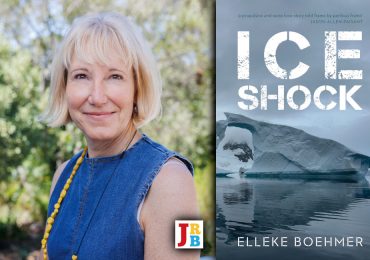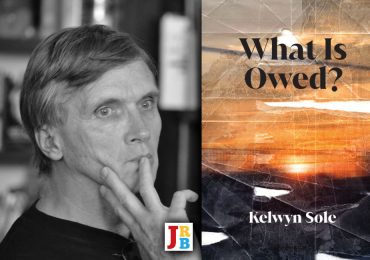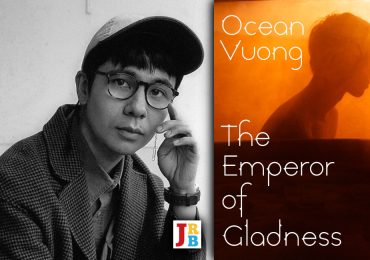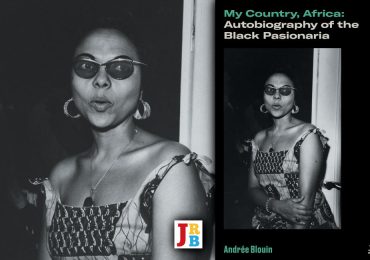Zadie Smith’s new collection of essays, Feel Free, is a too-rare pleasure, writes The JRB Editor Jennifer Malec.
Not many writers would get away with comparing Beyoncé to Muriel Spark, or with pointing out that when Wordsworth says, ‘I cannot paint/What then I was’, it is, in fact, a humble brag, or with pondering whether the actress and writer Mela Hartwig considered Virginia Woolf a ‘friend or frenemy’. Zadie Smith can, and does: all of these thoughts appear in her new collection of essays, Feel Free.
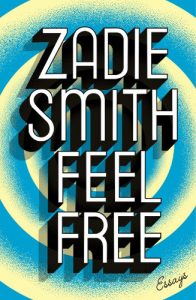
Feel Free
Zadie Smith
Hamish Hamilton, 2018
But, of course, it’s not all hat tips to amusing millennial slang. As in her 2009 collection of non-fiction, Changing My Mind, there are many moments of essayistic mastery in Feel Free. In a piece on the artist Mark Bradford, more precisely on his video ‘Niagara’, from the 2017 Venice Biennale, Smith defines the idea of ‘camp’ as ‘doing more than is necessary with less than you need’. The recording shows a young black man in the city, walking away from the camera ‘in a baggy pair of yellow shorts, battered boots, a half-ruined vest, and pristine white tube socks’—echoing of Marilyn Monroe’s legendary sashaying walk from the 1953 film, Niagara. The ‘less-than-you-need’ part of her definition is important, Smith writes, as:
Camp begins in lack, in absence. It is the nuclear option of the disenfranchised. When you take everything from the slave, for example—family, clothes, paper, ink, and finally even his drum—you then leave only the body, yes, only that. And one of the things the disenfranchised slave did with his body was the shim-sham, that fabulous dance of a walk, as camp as any movement on earth. Camp is our flagrant and delicious survival in the face of and despite the fact.
Doing more than is necessary with less than you need. The phrase is so self-contained it sounds like it comes from a distant, more aphoristic, age.
In ‘Generation Why’, Smith makes a leap back from 2003 to the third century BC—a leap so startling that, coming across it again, I remember it vividly from the first time I read the essay, in the New York Review of Books, in 2010. In the essay, Smith teases out the differences between the real Mark Zuckerberg and the Zuckerberg played by Jesse Eisenberg in the film The Social Network. Taking a cue from Zuckerberg’s New Yorker profile, in which it is revealed that his Facebook page lists his interests as ‘minimalism, revolutions, and “eliminating desire”‘, and his ‘affection for the culture and writings of ancient Greece’, Smith writes:
Perhaps this is the disjunct between real Zuckerberg and fake Zuckerberg: the movie places him in the Roman world of betrayal and excess, but the real Zuckerberg may belong in the Greek, perhaps with the Stoics (‘eliminating desire’?). There’s a clue in the two Zuckerbergs’ relative physiognomies: real Zuckerberg (especially in profile) is Greek sculpture, noble, featureless, a little like the Doryphoros (only facially, mind—his torso is definitely not seven times his head). Fake Mark looks Roman, with all the precise facial detail filled in. Zuckerberg, with his steady relationship and his rented house and his refusal to get angry on television even when people are being very rude to him (he sweats instead), has something of the teenage Stoic about him. And of course if you’ve eliminated desire you’ve got nothing to hide, right?
Here’s proof that readers looking for a demonstration of the essay in the style of Montaigne will not be disappointed. But more often, Feel Free‘s strength arises from Smith’s ability to pick out quotidian truths, which earn their intensity simply from the fact that you hadn’t noticed them. In the piece ‘Dance Lessons for Writers’, for example, she considers the similarities between Michael Jackson and Prince: both indebted to James Brown, both ‘terribly slight, long-necked, thin-legged, powered from the torso rather than the backside, which in both cases was improbably small’—as well as a vital difference: their wildly different dancing styles:
Prince and Jackson are nothing alike when they dance, and it’s very hard to bring to mind Prince dancing whereas it is practically impossible to forget Jackson. It sounds irrational, but try it for yourself. Prince’s moves, no matter how many times you may have observed them, have no firm inscription in memory, they never seem quite fixed or preserved. If someone asks you to dance like Prince, what will you do? Spin, possibly, and do the splits, if you’re able. But there won’t appear to be anything especially Prince-like about that.
Reading this passage, it is impossible not to close your eyes and imagine yourself dancing like Prince, and to fail in that imagining. In this way, Smith’s essays edge towards the poetic, at least by a definition such as Philip Larkin’s, in which poetry is ‘a verbal device that would preserve an experience indefinitely by reproducing it in whoever read the poem’. And Smith is, in some ways, the inheritor of a type of Englishness embodied by Larkin: unashamedly unpretentious but covertly intellectual, skilled at skewering, albeit fondly, cliches of English identity, preoccupied with our mortality—although Smith is less likely to impose her glumness on you on this score. Instead, she combats the seven signs of aging by, well, reading and writing.
Early on, for better or worse, I chose whose child I wanted to be: the child of the novel. Almost everything else was subjugated to this ruling passion, reading stories. As a consequence, I can barely add a column of double digits, I have not the slightest idea of how a plane flies, I can’t draw any better than a five-year-old. One of the motivations for writing novels myself is the small window of opportunity it affords for a bit of extracurricular study. I learned a little about genetics writing my first novel, and went quite far with Rembrandt during my third. But these are only little pockets of knowledge, here and there. I think Seneca is right: life feels longer the more you engage with it. (Look how short life felt to the poet Larkin. Look how little he did with it.)
And unlike Larkin—who when the Paris Review asked, ‘Is Jorge Luis Borges the only other contemporary poet of note who is also a librarian?’ replied, ‘Who is Jorge Luis Borges?’—Smith is generous with her learning. She is the kind of reader who reads with purpose, on a theme or genre, and in Feel Free mentions ‘an exploratory season of science fiction’, for example, or a ‘concerted effort to read writers who’ve made sex their primary concern’. Those of us with deplorably haphazard reading habits are fortunate to be able to latch onto her many references—and you can trust they are rabbit holes worth burrowing into. The book is sprinkled with oblique literary allusions, dropped into the text without comment—’if she is indeed one of the less deceived, it is not a form of knowledge that appears to have brought with it much peace or satisfaction, as we hope wisdom will’ (Larkin again, after Shakespeare); or, ‘For us, the image-map that has been made of the world is not exactly the same as the territory itself’ (Jorge Luis Borges, with a hint of David Foster Wallace). But there are also more concrete endorsements. My tasks, set to me by Feel Free, are to seek out the recently rediscovered author Paula Fox, ‘a supernatural writer’, and Edward St Aubyn, who writes autobiographical novels of ‘rich, acerbic comedy’ on the themes ‘parental death, heroin, childhood rape, emotional frigidity, suicide, alcoholism’. I also have new motivation to become rich, so that I can one day own a painting by Lynette Yiadom-Boakye. Other leads are less fruitful. The essay on Charlie Kaufman’s movie Anomalisa and how it relates to Schopenhauer’s On the Suffering of the World persuaded me to watch the film, which I had been avoiding. I remain unconvinced that Kaufman’s foray into puppetry is deserving of almost twenty pages of deliberation. The essays on The Social Network and Justin Bieber, too, feel over-long. But these disappointing recommendations are rare.
Reading Smith’s essays is a treat for fans of her novels, as some absorbing connections crop up. They are a source of minutiae, for those who are into that: ‘On Island Life and Mother Love’, an essay on Ian Thomson’s book The Dead Yard: A Story of Modern Jamaica, mentions Paul Bogle, the Baptist deacon and Jamaican National Hero who led the 1865 Morant Bay rebellion and was subsequently hanged by British authorities. This detail illuminates a minor character from Smith’s 2012 novel NW: Nathan Bogle, a clever, athletic, good looking boy who, tragically, ends up a drug-addicted vagrant. This gesture towards a mythical heritage makes Nathan Bogle’s fall all the more tragic.
In a short review of Danzy Senna’s short story collection You Are Free, Smith hints at where the crux of her most recent novel, Swing Time, may lie:
Reading [You Are Free], I had the same bittersweet sense many women had when they saw a black president arrive before a female one. On race, perhaps, we’re finally getting somewhere. But whatever became of sisterhood?
Swing Time is a book so rich it is difficult to pin down. After all the main character’s trials, when her career as assistant to the most famous pop star in the world comes dramatically and publicly crashing down, she returns to her working class neighbourhood in London. The novel ends with her on her way to pay a visit to her childhood friend Tracey, after being urged to do so by her dying mother. Tracey’s potential and talent for dance could not spare her from single parenthood and the dole, and the narrator has been bitterly estranged for many years:
I almost turned back, like someone who has woken abruptly from a sleepwalk, except for an idea, new to me, that there might be something else I could offer, something simpler, more honest, between my mother’s idea of salvation and nothing at all.
That idea, which the narrator had to travel around the world to discover right next door, is sisterhood.
Returning to ‘Dance Lessons for Writers’, specifically the section comparing David Byrne/David Bowie, ideas presented in Swing Time appear again:
People can be too precious about their ‘heritage’, about their ‘tradition’—writers especially. Preservation and protection have their place but they shouldn’t block either freedom or theft. All possible aesthetic expressions are available to all peoples—under the sign of love.
In the novel, these thoughts appear in the mouth of Aimee, the world-famous pop star, who dresses as an Asante noble for a concert:
I’d hesitantly brought up the matter of appropriation. […] Aimee looked at me and then down at her own ghost-pale pixie frame wrapped in so much vibrantly colored cloth, and told me that she was an artist, and artists have to be allowed to love things, to touch them and to use them, because art is not appropriation, that was not the aim of art—the aim of art was love. And when I asked her whether it was possible both to love something and leave it alone, she regarded me strangely, pulled her children into her body and asked: Have you ever been in love?
That this view should come from Aimee, whose self-centredness knows no bounds, could signal to a certain type of reader that Smith is not ‘woke’ enough. (Smith uses this word only once in Feel Free and there, as here, it is surrounded by scare quotes.) There are murmurings to this effect in a couple of reviews of the book. But the joy of Smith’s writing is that she is unafraid to take up an unpopular position. As she writes in the Foreword:
It’s true that for years I’ve been thinking aloud—and often wondering if I’ve made myself ludicrous in one way or another.
Smith’s acute thoughtfulness, her understanding that the self is ‘malleable and improvised’, ‘whose world is in no way “self-evident”‘, may be a position she admits is ‘wholly out of fashion’ today (most of the essays in Feel Free were written during the eight years of the Obama presidency, ‘and so are the product of a bygone world’), but it is a refreshing antidote to the oversimplified identity politics or racial essentialism that seem to shout the loudest in today’s world of letters.
Closer to home, the essay ‘On Island Life and Mother Love’ illustrates some instructive similarities between Jamaica and South Africa, two countries ravaged by colonialism and left violent and race obsessed. Describing Jamaica, Smith could also be describing South Africa:
[Jamaica’s colonial] history does not the foundation of a healthy modern state make, and the stability it took England six hundred years to achieve is unlikely to come to Jamaica in fifty. Jamaica is like an abused child: who can be surprised when the adult behaves so strangely?
Equally, Jamaica, like South Africa, is a country with a rich and resilient culture, a vibrant way with language and a significant musical tradition. Amusingly, as Smith points out, one of the symbols of the legacy of African culture in Jamaica is the phrase ‘soon come’, meaning that a thing could, or probably will, or might happen, today, tomorrow or sometime in the near future. The phrase has an uncanny echo in South Africa’s ‘just now’.
Smith frequently professes her ignorance—about painting, about serious philosophy, about music—but of course she is not ignorant by any measure a normal human would relate to. In spite of her regular bouts of self-deprecation, she writes assuredly about topics as diverse as Balthasar Denner’s eighteenth-century portrait ‘Alte Frau’, the relationship between Kierkegaard’s Fear and Trembling and Joni Mitchell, and Jay-Z’s career trajectory. The chapter in which, as an aside, she admits to not knowing that Talking Heads were responsible for the album More Songs About Buildings and Food, and wonders whether it’s too late in life for her to become a fan, is followed by ‘Dance Lessons for Writers’, in which she incisively, if briefly, analyses David Byrne’s dance moves.
As always, I’ll be eagerly awaiting Smith’s next novel—historical fiction this time, set in the mid-eighteen-hundreds in London—due out in 2019. But I’ll also be hoping that her fiction career becomes more regularly punctuated by non-fiction. Feel Free is a too-rare pleasure.
- Jennifer Malec is the Editor; follow her on Twitter.

